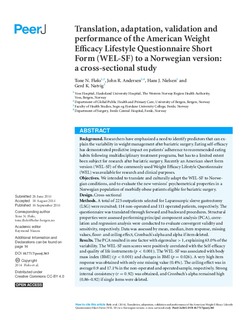| dc.contributor.author | Flølo, Tone Nygaard | |
| dc.contributor.author | Andersen, John Roger | |
| dc.contributor.author | Nielsen, Hans Jørgen | |
| dc.contributor.author | Natvig, Gerd Karin | |
| dc.date.accessioned | 2015-04-08T12:41:46Z | |
| dc.date.accessioned | 2016-12-07T14:33:11Z | |
| dc.date.available | 2015-04-08T12:41:46Z | |
| dc.date.available | 2016-12-07T14:33:11Z | |
| dc.date.issued | 2014 | |
| dc.identifier.citation | PeerJ 2014, 2014(1) | nb_NO |
| dc.identifier.issn | 2167-8359 | |
| dc.identifier.uri | http://hdl.handle.net/11250/2424557 | |
| dc.description.abstract | Background. Researchers have emphasized a need to identify predictors that can explain the variability in weight management after bariatric surgery. Eating self-efficacy has demonstrated predictive impact on patients’ adherence to recommended eating habits following multidisciplinary treatment programs, but has to a limited extent been subject for research after bariatric surgery. Recently an American short form version (WEL-SF) of the commonly used Weight Efficacy Lifestyle Questionnaire (WEL) was available for research and clinical purposes.
Objectives. We intended to translate and culturally adapt the WEL-SF to Norwegian conditions, and to evaluate the new versions’ psychometrical properties in a Norwegian population of morbidly obese patients eligible for bariatric surgery.
Design. Cross-sectional
Methods. A total of 225 outpatients selected for Laparoscopic sleeve gastrectomy (LSG) were recruited; 114 non-operated and 111 operated patients, respectively. The questionnaire was translated through forward and backward procedures. Structural properties were assessed performing principal component analysis (PCA), correlation and regression analysis were conducted to evaluate convergent validity and sensitivity, respectively. Data was assessed by mean, median, item response, missing values, floor- and ceiling effect, Cronbach’s alpha and alpha if item deleted.
Results. The PCA resulted in one factor with eigenvalue > 1, explaining 63.0% of the variability. The WEL-SF sum scores were positively correlated with the Self-efficacy and quality of life instruments (p < 0.001). The WEL-SF was associated with body mass index (BMI) (p < 0.001) and changes in BMI (p = 0.026). A very high item response was obtained with only one missing value (0.4%). The ceiling effect was in average 0.9 and 17.1% in the non-operated and operated sample, respectively. Strong internal consistency (r = 0.92) was obtained, and Cronbach’s alpha remained high (0.86–0.92) if single items were deleted.
Conclusion. The Norwegian version of WEL-SF appears to be a valid questionnaire on eating self-efficacy, with acceptable psychometrical properties in a population of morbidly obese patients. | nb_NO |
| dc.language.iso | eng | nb_NO |
| dc.rights | Navngivelse 4.0 Internasjonal | * |
| dc.rights.uri | http://creativecommons.org/licenses/by/4.0/deed.no | * |
| dc.title | Translation, adaptation, validation and performance of the American Weight Efficacy Lifestyle Questionnaire Short Form (WEL-SF) to a Norwegian version: a cross-sectional study | nb_NO |
| dc.type | Journal article | nb_NO |
| dc.type | Peer reviewed | nb_NO |
| dc.date.updated | 2015-04-08T12:41:46Z | |
| dc.subject.nsi | VDP::Medisinske fag: 700::Helsefag: 800::Samfunnsmedisin, sosialmedisin: 801 | nb_NO |
| dc.subject.nsi | VDP::Midical sciences: 700::Health sciences: 800::Community medicine, social medicine: 801 | nb_NO |
| dc.source.journal | PeerJ | nb_NO |
| dc.identifier.doi | 10.7717/peerj.565 | |
| dc.identifier.cristin | 1161463 | |

